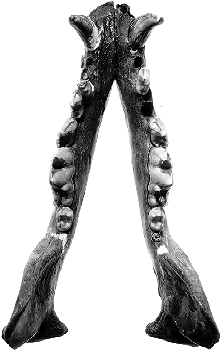



Carnivora: More on Morphology
 |
Carnivores can be told by their enlarged canine teeth, by the presence of three pairs of incisors in each jaw (with rare exceptions), and by the shape of their molar teeth. In humans and in many other mammals, the molars are flattened and are used for grinding food. In most carnivores (except for bears and pinnipeds), the last premolar of the upper jaw and first molar of the lower jaw are sharp and bladelike, and slide past each other like the blades of scissors when the animal chews. These modified molars are known as carnassial teeth. Molars farther back in the jaw are usually either missing or highly reduced. Both the carnassials and the enlarged canines are clearly visible in this fossil gray wolf jaw (left) from the La Brea tar pits in Los Angeles, California.
As you might expect, these features are adaptive for a carnivorous diet, to tear and cut meat; note that bears, which are almost all omnivorous, have re-evolved crushing molar teeth. Another carnivore feature is the jaw articulation; unlike many mammals, such as primates and ungulates, carnivores cannot move their jaws from side to side.
